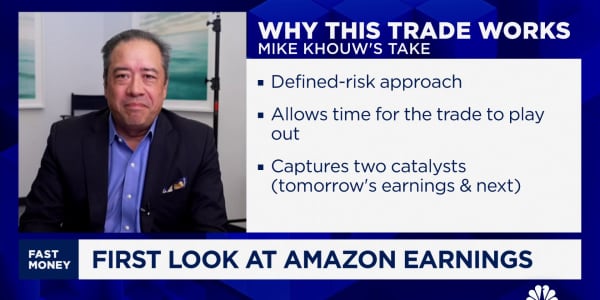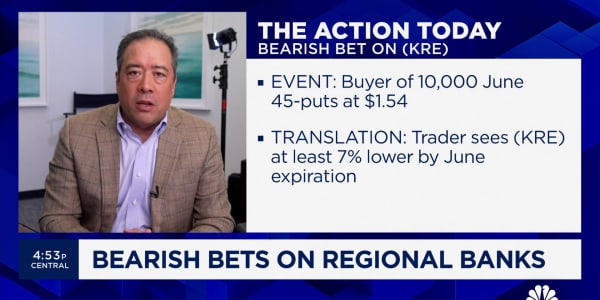
When looking at shares of Amazon, which just surmounted the $400 level, traders and analysts agree on one thing: Something has to give.
After all, this company is now worth $184 billion despite logging earnings per share of just $0.28 (making for a price-to-earnings ratio of more than 1,400). But while bearish traders believe the share price is due to drop, bullish analysts say that profits will rise as soon as CEO Jeff Bezos allows them to—which might not happen until the company becomes the world's dominant retailer.
One bear, Michael Khouw of Dash Financial, says that the company's fundamentals, even beyond earnings, simply tell a dour story.
"What most people are going to do is point to how expensive the stock is on a price-to-earnings ratio, for example," Khouw said. "You can't do that with Amazon, because they haven't had that much in terms of earnings—that's not what people are betting on. So maybe another way we might take a look at this is on a price-to-sales basis, thinking that someday the margin's actually going to show up."
Using a chart to illustrate his point about price-to-sales on CNBC's "Options Action," Khouw said Friday that "if you take a look at the longer-term chart, we are right near that high at almost 2.7-times sales. So if this is going to be our metric in terms of fundamental analysis, then maybe we're looking at the upper end of the range."
"Amazon has acted pretty irrationally, when you think about some of the fundamental stuff," sums up Dan Nathan of RiskReversal.com. "The stock is up 30 percent in this quarter alone. This thing has just gone parabolic."
But Nathan says he still can't get short.
"I think you'd have to be crazy to buy it, but it's also been a widow-maker on the short side," Nathan said. "At some point, something's got to give."
But to analysts like Michael Pachter of Wedbush Securities, what will eventually give is the company's massive expansion, allowing its margins to soar.
To Amazon's management, "as long as they're profitable by a dollar—not a dollar per share, but literally a dollar—with positive cash flow and positive profit, the Street should tolerate whatever they do. And the stock price tells you that investors are comfortable that the management is making the right decisions," Pachter said.
Pachter says Amazon will keep pouring its revenues into investment and infrastructure for the time being, and he rates the company neutral because "I don't know when they're going to turn the taps on" and start focusing on profitability. But he adds that "I don't question that Amazon will be the dominant retailer on the planet, and when they are, they'll be tremendously valuable."
Mark Mahaney of RBC Capital Markets says that in the near-term, what will drive Amazon is not price-to-earnings nor price-to-sales, but gross margin percentage (calculated by subtracting cost of goods sold from revenue, and dividing that by revenue).
"If the company can sustain 30 percent unit growth, and gross margins continue to expand, the market will continue to have a lot of patience in bottom-line profits," Mahaney told CNBC.com. "However, if gross margins start to flatline, then the company would have to show significant bottom-line profits in a quarter or two."
Mahaney says that this time of heavy investment is not unique in Amazon's history.
"The company has gone through a major investment cycle before," he said. "And what the market has essentially done is said: 'Instead of waiting, I'm going to buy it on faith.'"
So, as bearish traders point out, Amazon might be a faith-based stock for now. But analysts like Mahaney and Pachter predict that this faith will actually prove to be quite well-grounded.
—By CNBC's Alex Rosenberg. Follow him on Twitter: @CNBCAlex.






